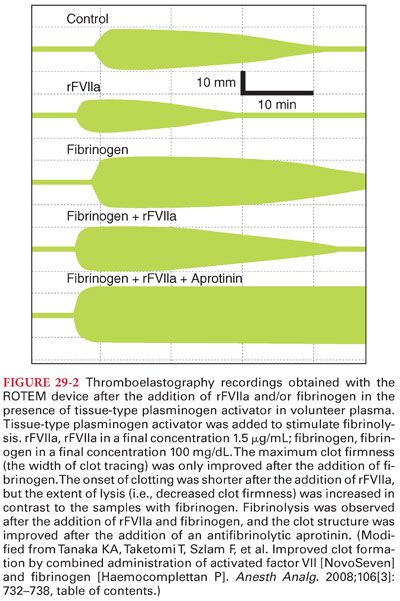B. When protamine is dosed based on the exact amount needed to reverse circulating heparin levels, it produces the lowest activated clotting time values.
C. Protamine can cause adverse reactions including anaphylaxis, acute pulmonary vasoconstriction and right ventricular failure, and hypotension.
1. Patients at an increased risk for adverse reactions are sensitized, often from exposure to neutral protamine Hagedorn, which contains insulin and protamine.
2. Other individuals reported at risk for protamine reactions include patients with vasectomy, multiple drug allergies, and prior protamine exposure.
V. Desmopressin (DDAVP) is the V2 analog of arginine vasopressin that stimulates the release of ultra large von Willebrand factor (vWF) multimers from endothelial cells.
A. DDAVP shortens the bleeding time of patients with mild forms of hemophilia A or von Willebrand’s disease (the most frequent inherited bleeding disorder).
B. The specific surgical patients that might benefit from use of DDAVP are not clear.
C. DDAVP should be administered by slow intravenous infusion to avoid hypotension because it stimulates endothelial cells releasing vasoactive mediators in addition to vWF.
VI. Fibrinogen is synthesized in the liver and a critical component of effective clot formation. It is the substrate of three important enzymes involved in clot formation: thrombin, factor (F) XIIIa, and plasmin.
A. Fibrinogen also acts as the binding site (ligand) for glycoprotein IIb/IIIa receptors, found on the platelet surface, which are responsible for platelet aggregation.
B. During major hemorrhage, hemodilution after blood loss and subsequent volume replacement leads to reduced fibrinogen levels impairing fibrin polymerization and reduces clot stability (fibrinogen supplementation to restore plasma fibrinogen is key to normalizing clotting function).
1. Fibrinogen is an underrecognized coagulation factor that is critical for producing effective clot in surgical patients (hypofibrinogenemia is a predictor of perioperative bleeding).
2. Normal fibrinogen levels are 200 to 400 mg/dL (during the third trimester of pregnancy, fibrinogen levels are elevated to >400 mg/dL).
C. A major problem with managing bleeding is that many transfusion algorithms recommend therapy only when fibrinogen levels are less than 100 mg/dL. Cryoprecipitate or fibrinogen concentrates are a better option to restore adequate plasma levels (~200 mg/dL) and need to be considered when treating life-threatening bleeding.
VII. Recombinant coagulation products are used to manage bleeding in hemophilia, von Willebrand’s disease, and in patients with acquired antibodies/inhibitors.
A. Recombinant activated factor VIIa (rFVIIa) is most widely known and approved for hemophilia patients with inhibitors to treat bleeding. The incidence of thrombotic complications among patients who received rFVIIa is relatively low. rFVIIa can normalize elevated international normalized ratio (INR)/prothrombin time values without actually correcting the coagulation defect, especially in patients receiving warfarin and other vitamin K antagonists.
B. Factor XIII (FXIII) is an important final step in clot formation that stabilizes the initial clot (reductions in FXIII during cardiopulmonary bypass and an inverse relationship between postoperative blood loss and postoperative FXIII levels).
C. Prothrombin complex concentrates (PCCs) include factors II, VII, IX, and X in variable concentrations (indicated for prevention/control of bleeding in patients with hemophilia B).
1. It is considered preferable to give a PCC containing all four vitamin K–dependent coagulation factors and the natural anticoagulants antithrombin and activated protein C (APC) for anticoagulation reversal.
D. Although warfarin reversal in the United States is typically achieved with fresh frozen plasma (FFP), most other countries use PCCs. Compared with FFP, PCCs provide quicker INR correction, have a lower infusion volume, and are more readily available without crossmatching.
E. Topical hemostatic agents are used intraoperatively to promote hemostasis at the site of vascular injury and include physical and mechanical agents, caustic agents, biologic physical agents, and physiologic agents.
1. Absorbable agents include gelatin sponges (Gelfoam), derived from purified pork skin gelatin that increase contact activation to help create topical clot. Surgicel or Oxycel are oxidized regenerated cellulose that work like Gelfoam. Avitene is microfibrillar collagen derived from bovine skin.
2. Collagen sponges are available in different commercial forms and are derived from bovine Achilles tendon or bovine skin. Gelatin foam should not be used near nerves or in confined spaces but can be administered topically with thrombin.
3. Topically applied thrombin preparations are used extensively.
4. Fibrin sealants (biologic glue or fibrin tissue adhesives) are component products that combine thrombin (mostly human) and fibrinogen.
VIII. Summary
A. The potential for bleeding in surgical patients represents an ongoing problem for clinicians (increasing use of anticoagulation agents creates a need for multiple pharmacologic approaches).
B. Therapy should be multimodal when managing perioperative hemostasis (Fig. 29-2).

Stay updated, free articles. Join our Telegram channel

Full access? Get Clinical Tree


